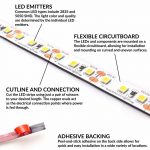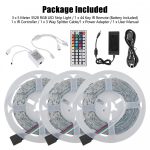Last Updated on 9 months by Francis
.jpg)
LED light strips have gained popularity in recent years due to their versatility and energy efficiency. If you are considering installing LED light strips, it’s important to understand the cost of running them. The cost of running LED light strips depends on several factors, such as the wattage of the strips, the number of hours of usage per day, and the electricity rate. By calculating the cost, you can make informed decisions and find budget-friendly options to minimize expenses. This article will provide an introduction to LED light strips, explain how they work, discuss the factors affecting the cost of running LED light strips, and provide budget-friendly tips to help you save on energy costs.
Contents
Key takeaway:
- LED light strips are cost-effective: LED light strips have lower wattage, resulting in reduced electricity usage and cost savings compared to traditional lighting options.
- Consider energy-efficient LED light strips: Opt for energy-efficient LED light strips to further minimize operating costs while maintaining adequate illumination.
- Implement cost-saving measures: Install dimmers or motion sensors, turn off lights when not in use, and backlighting drawers to optimize energy efficiency and reduce expenses associated with running LED light strips.
How Do LED Light Strips Work?
LED light strips work by utilizing light-emitting diodes (LEDs) to convert electrical energy into light energy. When an electric current is applied to the LED, electrons combine with electron holes in the semiconductor material, releasing energy in the form of photons, which creates visible light. The LEDs on the strip can be arranged in various configurations to produce different colors and lighting effects. To control the LED light strips, a controller is used, allowing users to adjust the brightness, color, and lighting effects. LED light strips can be used for various applications, including accent lighting, task lighting, and decorative lighting. They are commonly used for under-cabinet lighting, cove lighting, and backlighting for TVs or displays.
Factors Affecting the Cost of Running LED Light Strips
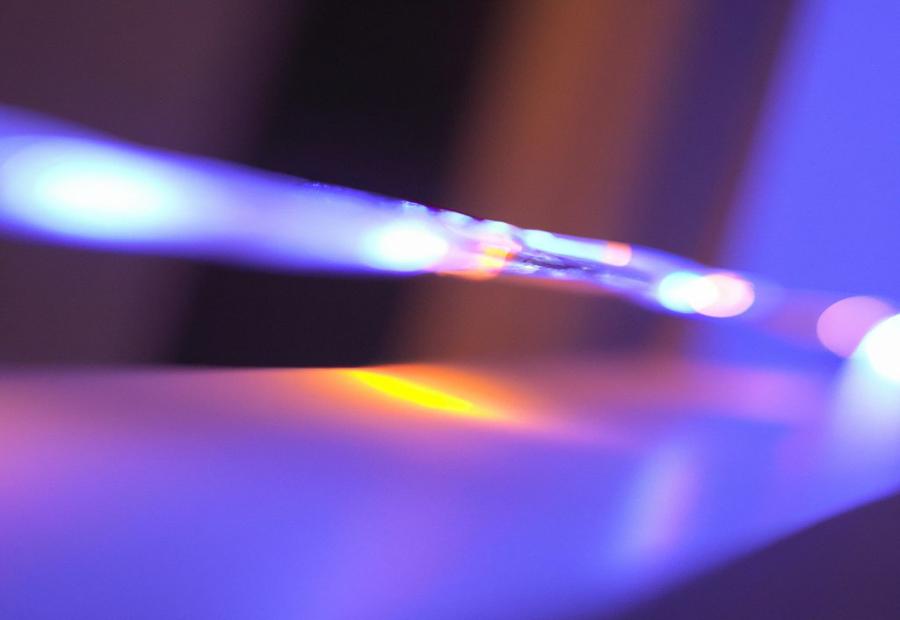
Photo Credits: Infraredforhealth.Com by Austin Carter
Curious about the cost of running LED light strips? Let’s take a look at the factors that influence this expense. From the wattage of the LED light strips to the hours of usage per day and the electricity rate, each of these sub-sections will shed light on different aspects that contribute to the overall cost. So, buckle up and discover the ins and outs of running LED light strips efficiently and economically.
Wattage of the LED Light Strips
When choosing LED light strips, it’s important to consider the wattage. Understanding the wattage of the LED light strips helps you make an informed decision and ensures that you choose the right strips that meet your specific lighting needs. Here are some key points to keep in mind:
- The wattage of the LED light strips refers to the amount of power they consume. This is a crucial factor as it determines the energy efficiency and cost of running the LED light strips.
- LED light strips are available in a range of wattages, from low wattage options to higher wattage options. It is essential to choose a wattage that aligns with your specific lighting requirements.
- Lower wattage LED light strips are ideal for accent lighting or ambient lighting where a subtle glow is desired. These strips consume less power and provide energy savings.
- Higher wattage LED light strips are suitable for task lighting or applications that require brighter illumination. These strips provide more intense light but may consume more power.
- When selecting LED light strips based on wattage, consider the purpose and desired effect of the lighting. Determine whether you need a softer, energy-efficient glow or a brighter, more intense illumination.
Consider the wattage of the LED light strips alongside other factors such as color temperature, brand, and quality to make the best choice for your lighting project.
Hours of Usage per Day
When considering the cost of running LED light strips, the number of hours of usage per day plays a crucial role. The table below illustrates the impact of varying hours of usage per day on the cost of running LED light strips.
| Hours of Usage per Day | Monthly Electricity Cost | Annual Electricity Cost |
| 2 hours | $2.40 | $28.80 |
| 4 hours | $4.80 | $57.60 |
| 6 hours | $7.20 | $86.40 |
| 8 hours | $9.60 | $115.20 |
As shown in the table, the longer the hours of usage per day, the higher the monthly and annual electricity costs will be for running LED light strips. Therefore, it’s important to consider your daily usage habits and adjust accordingly to manage energy consumption and cost-effectiveness of the lighting.
To optimize cost savings, it’s recommended to use energy-efficient LED light strips, install dimmers or motion sensors to control usage, and remember to turn off lights when not in use. By implementing these strategies, you can efficiently manage the hours of usage per day and reduce electricity costs.
Electricity Rate
| Electricity Rate | Cost per Kilowatt-hour (kWh) |
|---|---|
| Residential Rate | $0.12 |
| Commercial Rate | $0.10 |
| Industrial Rate | $0.08 |
When considering the cost of running LED light strips, the electricity rate is an essential factor to take into account. The Electricity Rate, often measured in cost per kilowatt-hour (kWh), varies depending on the type of consumer.
For residential consumers, the average electricity rate is around $0.12 per kWh. This means that for every kilowatt-hour of electricity used, you would be charged $0.12.
Commercial consumers, on the other hand, typically have a lower electricity rate of approximately $0.10 per kWh. This lower rate is often offered to businesses due to the higher volume of electricity they consume.
Industrial consumers have the lowest electricity rate, usually around $0.08 per kWh. This rate is granted to industries that require substantial amounts of electricity for their operations.
Understanding the electricity rate is crucial in calculating the cost of running LED light strips. By multiplying the electricity rate by the wattage consumed by the LED light strips and the number of hours of usage per day, you can determine the approximate cost of running the lights.
Budget-Friendly Tips for Running LED Light Strips
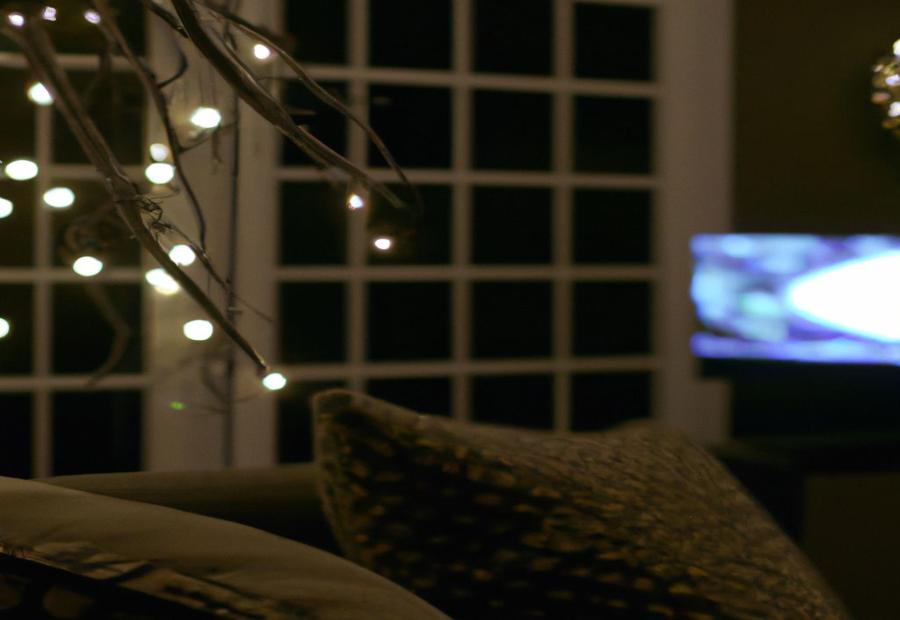
Photo Credits: Infraredforhealth.Com by Jacob Martinez
Looking to save some bucks while illuminating your space? Look no further! In this section, we’ll dive into some budget-friendly tips for running LED light strips. Discover the benefits of using energy-efficient LED light strips, explore the advantages of installing dimmers or motion sensors, and learn the importance of turning off lights when not in use. Plus, don’t miss out on the clever trick of backlighting drawers for a stylish and functional touch. Let’s shed some light on your budget without sacrificing style!
Use Energy-Efficient LED Light Strips
When it comes to using LED light strips, it is essential to prioritize energy efficiency. By utilizing energy-efficient LED light strips, you can effectively reduce electricity costs and minimize your environmental impact.
- When selecting LED light strips, opt for products that possess high energy efficiency ratings. Look out for items that are marked as ENERGY STAR certified or have a notable lumens-per-watt ratio.
- Make a choice of LED light strips that offer dimmable features. This enables you to adjust the brightness level according to your requirements, resulting in further energy conservation.
- Consider LED light strips equipped with motion sensors. These sensors can detect movement and automatically turn the lights on or off, ensuring they are only in use when necessary.
- Remember to turn off the lights when not in use. Even energy-efficient LED light strips consume electricity when left unnecessarily on. Develop a habit of switching them off when exiting a room.
By incorporating energy-efficient LED light strips into your routine and embracing these practices, you can significantly reduce your energy consumption and actively contribute to a more sustainable environment.
Install Dimmers or Motion Sensors
When it comes to running LED light strips, installing dimmers or motion sensors can provide several benefits:
- Energy savings: Installing dimmers or motion sensors allows you to control the brightness and automatically turn off the lights when they are not needed. This helps to reduce energy consumption and ultimately lowers your electricity bill.
- Extended lifespan: By dimming the lights or only activating them when motion is detected, you can reduce the amount of time the LED light strips are in use. This helps to prolong their lifespan, saving you money on replacements.
- Enhanced flexibility: Dimmers provide the flexibility to adjust the lighting according to your preference or the occasion. You can create a cozy ambiance by lowering the brightness or increase it for task lighting purposes.
- Improved convenience: Motion sensors automatically turn on the lights when someone enters the room or area, eliminating the need to manually switch them on. This adds convenience and ensures that you never forget to turn off the lights when leaving.
- Safety and security: Dimmers and motion sensors can also act as a security feature by creating the illusion of someone being home even when you’re away. This can deter potential intruders.
By installing dimmers or motion sensors, you not only save energy and money but also enhance convenience, flexibility, and safety.
Turn Off Lights When Not in Use
To conserve energy and save on costs, it is important to follow these steps for turning off lights when they are not in use:
- Develop a habit of switching off lights when leaving a room. By taking this simple action, you can significantly reduce energy consumption.
- Consider installing motion sensors or timers in rooms where lights are unintentionally left on. These devices automatically switch off lights when no motion is detected for a specific period.
- Make use of natural light during the day by opening curtains or blinds. Instead of relying solely on artificial lighting, take advantage of daylight to brighten your space.
- Create a reminder system that prompts you to turn off lights before leaving the house or going to bed. This can be as easy as setting a recurring alarm or utilizing smart home technology to automate the process.
- Encourage family members or colleagues to adopt the habit of turning off lights when they are not needed. By practicing collective responsibility, energy-saving practices can be consistently implemented.
- Consider using energy-efficient LED light strips that consume less electricity compared to traditional lighting options. LED lights are highly efficient and can aid in reducing energy costs.
- Implement a lighting control system that allows you to easily manage and monitor the usage of lights in different areas of your home or workplace. This can help identify areas where lights are frequently left on and enable you to take corrective actions.
By following these steps and consciously making an effort to turn off lights when they are not in use, you can contribute to energy conservation and save on costs.
Backlighting Drawers
To properly backlight drawers using LED light strips, it is helpful to create a table to organize the information effectively:
| Factors to Consider | Description |
|
Light Color |
Choose LED light strips with a color temperature that complements the ambiance of the space. Warm white or cool white options are commonly used for backlighting drawers. |
|
Strip Length |
Determine the length of LED light strip needed to cover the area of the drawer. Measure the dimensions accurately and choose a strip that matches or can be cut to fit. |
|
Installation Method |
Select the installation method that suits the drawer configuration. Options include adhesive backing, mounting brackets, or channels. |
|
Power Source |
Ensure the LED light strip can be easily connected to an appropriate power source. Some strips may require a separate power adapter or transformer. |
|
Dimming Option |
If desired, choose LED light strips with dimming capabilities to adjust the brightness based on preferences and needs. |
When backlighting drawers, it is important to consider factors such as the light color, strip length, installation method, power source, and dimming options. Taking these factors into account will help achieve the desired lighting effect and enhance the functionality and aesthetics of the drawers. Ensure that the LED light strips chosen match the color temperature of the surrounding space and that the strip length covers the dimensions of the drawer adequately. Additionally, consider the method of installation, whether adhesive backing, mounting brackets, or channels are most suitable. Connect the LED light strips to a power source that is easily accessible, and if desired, select strips with dimming options to control the brightness. By considering these factors, you can effectively backlight your drawers with LED light strips.
Comparison between LED Light Strips and Traditional Lighting
LED light strips have gained immense popularity in recent years, offering a range of benefits that set them apart from traditional lighting options. In this section, we’ll delve into a comparison between LED light strips and traditional lighting, exploring the cost savings, energy efficiency, long lifespan, light density, and low heat output that LED light strips bring to the table. Buckle up and get ready to illuminate your understanding of the remarkable advantages these modern lighting wonders have to offer!
Cost Savings
The use of LED light strips can lead to significant cost savings compared to traditional lighting options. Here are some factors to consider:
- Energy Efficiency: LED light strips are highly energy-efficient, consuming less electricity than traditional lighting methods. On average, LED lights use about 75% less energy than incandescent bulbs, resulting in reduced energy costs and potential cost savings.
- Long Lifespan: LED light strips have a longer lifespan compared to traditional lighting options. They can last up to 50,000 hours, reducing the frequency of bulb replacements and saving on replacement costs, contributing to overall cost savings.
- Low Heat Output: LED light strips produce significantly less heat compared to traditional lighting methods. This not only reduces the risk of fire hazards but also lowers cooling costs as air conditioners do not need to work as hard, resulting in additional cost savings.
- Reduced Maintenance Costs: LED light strips require minimal maintenance due to their long lifespan. This means fewer maintenance visits and lower service costs, contributing to cost savings over time.
To maximize cost savings when using LED light strips, consider implementing the following suggestions:
- Install Dimmers or Motion Sensors: Dimmers and motion sensors can help regulate lighting levels and turn off lights when not in use, reducing unnecessary energy consumption and further enhancing cost savings.
- Turn Off Lights When Not in Use: Encourage the habit of turning off LED light strips when leaving a room to save on electricity costs and increase overall cost savings.
- Use Energy-Efficient LED Light Strips: Choose LED light strips with high energy efficiency ratings to ensure optimal cost savings and maximize the potential for reducing expenses.
Energy Efficiency
When choosing LED light strips, it is crucial to consider energy efficiency. LED lights are known for their highly energy-efficient nature, consuming significantly less electricity compared to traditional options.
One of the reasons why LED light strips are energy-efficient is their high luminous efficacy. This means that they produce more light output per watt of electricity consumed. As a result, energy consumption and electricity costs are reduced. In fact, LED light strips can be up to 80% more energy efficient compared to traditional incandescent bulbs.
Another aspect of energy efficiency with LED light strips is their long lifespan. They can last up to 50,000 hours or even more, which means fewer replacements are needed. This not only saves energy but also reduces costs.
When looking for LED light strips, it is important to consider their energy efficiency ratings. Pay attention to the lumens per watt, as it indicates the amount of light produced per unit of electricity consumed. The higher the lumens per watt value, the greater the energy efficiency.
To further enhance energy efficiency, it is recommended to use dimmers or motion sensors with LED light strips. These tools allow for adjusting the brightness or automatically turning off the lights when they are not in use. By doing so, energy consumption can be further reduced.
By selecting energy-efficient LED light strips and implementing energy-saving strategies, it is possible to minimize the environmental impact and lower electricity bills.
Long Lifespan
LED light strips are known for their impressive long lifespan, which makes them a highly durable lighting option suitable for a wide range of applications. On average, these LED light strips can last around 50,000 hours, thanks to the use of efficient technology in their production. Unlike traditional lighting alternatives, LED light strips do not burn out suddenly or fail unexpectedly. Instead, they gradually diminish in brightness over time.
The substantial lifespan of LED light strips brings several advantages. Firstly, it significantly reduces the frequency of replacements, resulting in cost savings on maintenance expenses. Furthermore, it ensures consistent lighting performance for an extended period, which is particularly crucial in settings such as commercial or industrial environments where constant illumination is necessary.
Moreover, the long lifespan of LED light strips contributes to their energy efficiency. With their extended operational life, these strips require fewer replacements, leading to reduced overall energy consumption and waste. This aspect makes LED light strips an environmentally friendly choice for lighting purposes.
When selecting LED light strips, it is crucial to consider their rated lifespan. It is advisable to opt for products that offer a long lifespan to secure long-term cost savings and reliability. Factors to consider include the quality of the LED chips, the materials used in their construction, and any warranties provided by the manufacturer.
Light Density
When it comes to LED light strips, one important factor to consider is light density. Light density refers to the amount of light emitted per unit of length or area of the light strip.
| Brand | Light Density (Lumens per Meter) |
| Brand A | 900 |
| Brand B | 1200 |
| Brand C | 1500 |
As seen in the table above, different brands of LED light strips offer varying light densities. Brand C, for example, has a higher light density of 1500 lumens per meter compared to Brand A’s 900 lumens per meter. Choosing a light strip with higher light density can provide a brighter and more illuminated space.
When selecting LED light strips, it’s essential to evaluate your lighting needs and the desired level of brightness. If you need an intense and vibrant lighting effect, opt for a light strip with a higher light density. However, if you prefer a more subtle and ambient lighting, a lower light density may be sufficient.
Consider the specific application and space where the LED light strips will be used. For areas that require focused lighting, such as task or work areas, a higher light density may be preferable. On the other hand, for areas where a soft and diffused glow is desired, a lower light density may be more suitable.
Keep in mind that light density is just one aspect to consider when choosing LED light strips. It’s also important to consider factors like color temperature options, brand and quality, and lumens and wattage per meter to ensure you select the right LED light strip for your needs.
Low Heat Output
When choosing LED light strips, it is important to consider the factor of low heat output. There are several reasons why low heat output is beneficial:
- Energy efficiency: LED light strips are highly energy efficient as they produce very little heat compared to traditional lighting options. This means that a greater percentage of energy is used for producing light, resulting in improved energy efficiency.
- Safety: Low heat output reduces the risk of accidental burns or fire hazards. It also allows for installation in areas where heat-sensitive materials may be present.
- Long lifespan: The reduced heat production of LED light strips helps extend their lifespan. High temperatures can cause degradation of materials and lead to premature failure.
- Comfort: LED light strips with low heat output emit less heat into the surrounding environment, providing a more comfortable and cooler lighting experience.
- Versatility: The low heat output of LED light strips allows for their placement in small and confined spaces without the risk of overheating.
Considering these benefits, it is clear that low heat output is an important feature to prioritize when selecting LED light strips for your lighting needs.
Choosing the Right LED Light Strip
When it comes to choosing the right LED light strip, there are a few key factors to consider. We’ll explore the lumens and wattage per meter, the diverse color temperature options, and the importance of brand and quality. Get ready to uncover the secrets of finding the perfect LED light strip that suits your needs and preferences. Buckle up and let’s shed some light on this illuminating subject!
Lumens and Wattage per Meter
The sub-topic “Lumens and Wattage per Meter” is an important consideration when choosing LED light strips. This information can help determine the brightness and energy efficiency of the light strip.
| Lumens per Meter | Wattage per Meter |
| 400 | 4 |
| 800 | 8 |
| 1200 | 12 |
The lumens per meter indicate the brightness level of the LED light strip. Higher lumens mean brighter light. For example, a light strip with 1200 lumens per meter will provide more brightness compared to one with 400 lumens per meter.
The wattage per meter refers to the amount of power consumed by the LED light strip. A lower wattage indicates higher energy efficiency. For instance, a light strip with 4 watts per meter consumes less electricity compared to one with 12 watts per meter.
Choosing the right combination of lumens and wattage per meter depends on your specific lighting needs. If you require bright and energy-efficient lighting, opt for LED light strips with higher lumens and lower wattage per meter.
In a similar vein, when I was renovating my home office, I wanted to create a well-lit and productive space without consuming excessive electricity. After careful research and consideration, I decided to install LED light strips with 800 lumens per meter and 8 watts per meter. This combination provided the perfect balance of brightness and energy efficiency, allowing me to work comfortably while minimizing the environmental impact and energy costs. The LED light strips have transformed my office into a well-lit and energy-efficient workspace, helping me stay focused and productive throughout the day.
Color Temperature Options
When selecting LED light strips, it is important to consider the range of color temperature options available. The color temperature of a light source plays a significant role in determining the overall appearance and atmosphere created by the lighting.
| Color Temperature | Description |
| Warm White (2700K-3000K) | Warm White provides a cozy and intimate feel, similar to traditional incandescent bulbs. It is an ideal choice for areas that require a relaxed and comfortable ambiance, such as living rooms and bedrooms. |
| Cool White (4000K-5000K) | Cool White offers a more energetic and vibrant feel. It produces a bright, crisp, and clear light that is perfect for task-oriented areas like kitchens, bathrooms, and workspaces. |
| Daylight (5000K-6500K) | Daylight color temperature simulates natural daylight, providing a bright and invigorating illumination. It is an excellent choice for spaces that require maximum visibility, such as garages, workshops, and retail stores. |
When deciding on the color temperature for your LED light strips, consider the desired purpose and ambiance in each space. You can also create a layered and dynamic lighting design by combining different color temperatures in different areas.
Brand and Quality
When considering LED light strips, brand and quality are key factors to consider for optimal performance and longevity. The brand of LED light strip you choose can directly impact the quality and performance of the lights. Established brands like Philips and GE are known for their excellent quality, while Osram and LEDMO offer good and moderate quality, respectively. TBI Pro is an average brand that provides satisfactory results.
Investing in a reputable brand ensures that the LED light strips are made with high-quality materials, are reliable, and offer better color accuracy and brightness. Additionally, reputable brands often provide warranties, which can give you peace of mind.
Pro-tip: To determine the quality of a brand, check customer reviews and ratings online. This will give you insight into the experiences of other users and help you make an informed decision.
Some Facts About How Much LED Light Strips Cost to Run:
- ✅ LED strip lights use significantly less electricity than traditional incandescent and fluorescent bulbs. They can use up to 85% less electricity than incandescent bulbs. (Source: InStyle LED)
- ✅ The power consumption of LED strip lights depends on factors such as light density and diode size. A typical strip uses around 6.5 Watts per 5 meters. (Source: LED Lighting Info)
- ✅ LED strip lights have a longer lifespan compared to traditional bulbs. They can last up to 50,000 hours, reducing the need for frequent replacements. (Source: InStyle LED)
- ✅ The cost of running LED strip lights for a year is relatively low. A 5-meter strip costs just over $3 to run, while a 15-meter strip costs less than $27. (Source: LED Lighting Info)
- ✅ LED strip lights are energy-efficient and cost-effective. They provide more light and generate less heat at a lower cost compared to traditional bulbs. (Source: InStyle LED)
Frequently Asked Questions
1. How much do LED light strips cost to run?
LED light strips have low power consumption and are cost-effective to run. A standard 5-meter strip typically uses around 6.5 Watts and costs just over $3 per year to run on average. Longer strips or higher-density strips may require more power, but the overall cost remains relatively low.
2. Do LED light strips use less electricity than traditional incandescent lights?
Yes, LED light strips consume significantly less electricity than traditional incandescent lights. They use approximately 85% less electricity, resulting in lower energy bills and reduced carbon emissions. LED technology provides energy-efficient lighting solutions for both residential and commercial applications.
3. How long do LED light strips last?
LED light strips have a long lifespan compared to other lighting options. With an estimated lifespan of 50,000 hours, LED light strips can last up to 25 times longer than incandescent bulbs and up to 3 times longer than fluorescent bulbs. This extended lifespan not only saves on replacement costs but also reduces the environmental impact of manufacturing new bulbs.
4. What are the advantages of using high-quality LED light strips?
High-quality LED light strips offer several advantages. They provide better brightness and color quality, ensuring optimal lighting for various spaces. Additionally, they are designed to dissipate heat effectively, minimizing the risk of overheating and prolonging their lifespan. Choosing reputable brands like Lepro, Philips Hue, or Govee ensures durability, safety, and longevity.
5. Can LED light strips be left on for extended periods?
Yes, LED light strips are safe to leave on for extended periods. Their low heat output reduces the fire risk associated with traditional lighting fixtures. LED technology produces less heat, making them a safer option for continuous use. However, it’s important to consider energy consumption and cost, as leaving the lights on all night will increase electricity usage compared to shorter durations.
6. What are the environmental benefits of LED strip lights?
LED strip lights offer significant environmental benefits. They are highly energy-efficient, using up to 85% less electricity than traditional incandescent bulbs and 18% less than CFLs. LEDs also convert a higher percentage of supplied energy into light, reducing energy demand and greenhouse gas emissions. Furthermore, LED components are non-toxic, making them safer for the environment compared to fluorescent lights that contain mercury.

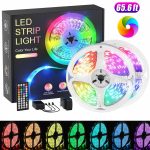
.jpg)
